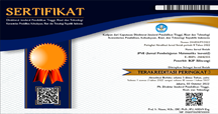KEMAMPUAN PEMECAHAN MASALAH MATEMATIS SISWA MTS PADA MATERI HIMPUNAN
DOI:
https://doi.org/10.22460/jpmi.v5i2.10289Keywords:
Mathematical Problems, Problem Solving Skills, SetAbstract
Students often answer the question given by the teacher in a trial manner, in which when answering the question of students not understanding the question first, on the reason that the problem given is different from the problem studied so that the student assumes that math lessons are hard to understand and make the head dizzy, because it causes the obtained results to be wrong. Therefore, the study aims to describe the potential mathematical solution of class VIII MTs students in assembly material at one of the schools in the khanebic district. The research method used is qualitative descriptive. The data analysis technique used was an interactive model of miles and hubermans. The subject used in the study is an eighth grader of 15 students taken under temptive sampling. The test instrument used is to describe the problem-solving and non-tes ability by conducting an interview. Results from the study indicate that the ability to solve a student's mathematical problem falls into three categories, with 26.7% of the student is high, 133% are moderate and 60% are low. The results suggest that students' capacity for mathematical problem solving is relatively low, which means there are several indicators of an optimum problem solving capability.Â
References
Amaliah, F., Sutirna, & Zulkarnaen, R. (2021). Analisis kemampuan Pemecahan Masalah Matematis Siswa pada Materi Segiempat dan Segitiga. 12(1), 10–20.
Azwar, S. (2006). Reliabilitas dan Validitas. Yogyakarta: Pustaka Pelajar.
Fuadi, R., Johar, R., & Munzir, S. (2016). Peningkatkan Kemampuan Pemahaman dan Penalaran Matematis melalui Pendekatan Kontekstual. 3(1), 47–54. https://doi.org/10.24815/jdm.v3i1.4305
Kamilah, M., & Imami, A. I. (2019). Analisis Kemampuan Komunikasi Matematis Siswa Smp Pada Materi Segitiga Dan Segiempat. Jurnal Cendekia : Jurnal Pendidikan Matematika, 2(1), 97–104. https://doi.org/10.31004/cendekia.v2i1.36
Khoirunisa, L., & Hartati, L. (2017). Kemampuan Pemecahan Masalah Matematika Ditinjau dari Kreativitas dan Kecerdasan Emosional. Jurnal Analisa, 3(2), 106–114. https://doi.org/10.15575/ja.v3i2.2011
Kudsiyah, S. M., Novarina, E., & Lukman, H. suryani. (2017). Faktor-Faktor Yang Mempengaruhi Kemampuan Pemecahan Masalah Matematika Kelas X Di Sma Negeri 2 Kota Sukabumi. Education: Prodi Pendidikan Matematika FKIP Universitas Muhammadiyah Sukabumi, 110–117.
Latifah, N. I. W., & Sutirna, S. (2021). Strategi Pemecahan Masalah Matematis Siswa pada Materi Himpunan di Masa Pandemi Covid-19. Jurnal Pembelajaran Matematika Inovatif, 4(3), 541–550. https://doi.org/10.22460/jpmi.v4i3.541-550
Mariam, S., Nurmala, N., Nurdianti, D., Rustyani, N., Desi, A., & Hidayat, W. (2019). Analisis Kemampuan Pemecahan Masalah Matematis Siswa MTsN dengan Menggunakan Metode Open Ended di Bandung Barat. Jurnal Pendidikan Matematika, 3(1), 178–186.
Nashoba, D. R. (2019). Pengaruh Gender terhadap Kemampuan Pemecahan Masalah Siswa Kelas VII pada Pokok Bahasan Himpunan dikontrol dengan Kemampuan Berpikir Kritis di MTs Darul Amanah. Αγαη, 8(5), 55.
NCTM. (2000). Principles and Standards for School Mathematics.
Nurjan, S. (2016). Psikologi Belajar. In Wadw Grup.
Polya. (1973). How to Solve it. Coastal And Estuarine Processes, pp. 1–360. https://doi.org/10.1142/7114
Purnamasari, I., & Setiawan, W. (2019). Analisis Kemampuan Pemecahan Masalah Matematis Siswa SMP pada Materi SPLDV Ditinjau dari Kemampuan Awal Matematika. Journal of Medives : Journal of Mathematics Education IKIP Veteran Semarang, 3(2), 207. https://doi.org/10.31331/medivesveteran.v3i2.771
Putra, H. D., Thahiram, N. F., Ganiati, M., & Nuryana, D. (2018). Kemampuan Pemecahan Masalah Matematis Siswa SMP pada Materi Bangun Ruang Development of Project-Based Blended Learning Model to Support Student Creativity in Designing Mathematics Learning in Elementary School. JIPM (Jurnal Ilmiah Pendidikan Matematika), 6(2), 82–90.
Ramadhani, D. A., & Hakim, D. L. (2021). Kemampuan Problem-Solving Matematis Siswa SMA dalam Menyelesaikan Permasalahan Materi Fungsi. Jurnal Pembelajaran Matematika Inovatif, 4(5), 1113–1122. https://doi.org/10.22460/jpmi.v4i5.1113-1122
Sholihah, D. A., & Mahmudi, A. (2015). Keefektifan Experimen Learning Pembelajaran Matematika MTs Materi Bangun Ruang Sisi Datar. Jurnal Riset Pendidikan Matematika, 2(2), 175. https://doi.org/10.21831/jrpm.v2i2.7332
Siregar, N. R. (2017). Persepsi siswa pada pelajaran matematika: studi pendahuluan pada siswa yang menyenangi game. Prosiding Temu Ilmiah X Ikatan Psikologi Perkembangan Indonesia, 224–232.
Sugiyono. (2016). Metode Penelitian Pendidikan Pendekatan Kuantitatiif, Kualitatif, dan R&D. Bandung: Alfabeta.
Sumartini, T. S. (2018). Peningkatan Kemampuan Pemecahan Masalah Matematis Siswa melalui Pembelajaran Berbasis Masalah. Mosharafa: Jurnal Pendidikan Matematika, 5(2), 148–158. https://doi.org/10.31980/mosharafa.v5i2.270
Suryani, M., Jufri, L. H., & Putri, T. A. (2019). Analisis Kemampuan Pemecahan Masalah Siswa Berdasarkan Kemampuan Awal. Jurnal Pendidikan Matematika, 8(1)(1), 119–130.
Trisniawati. (2017). Analisis Kemampuan Pemecahan Masalah Matematis Siswa Tingkat Sekolah Dasar di Kotamadya Yogyakarta. SCIENCE TECH: Jurnal Ilmiah Ilmu Pengetahuan Dan Teknologi, 3(1), 1–10.
Utami, R. W., & Wutsqa, D. U. (2017). Analisis kemampuan pemecahan masalah matematika dan self-efficacy siswa SMP negeri di Kabupaten Ciamis. Jurnal Riset Pendidikan Matematika, 4(2), 166. https://doi.org/10.21831/jrpm.v4i2.14897
UU Tahun 20 Nomor, T. 20 N. (2003). Sistem Pendidikan Nasional. Acta Pædiatrica, 71, 6–6. https://doi.org/10.1111/j.1651-2227.1982.tb08455.x

















